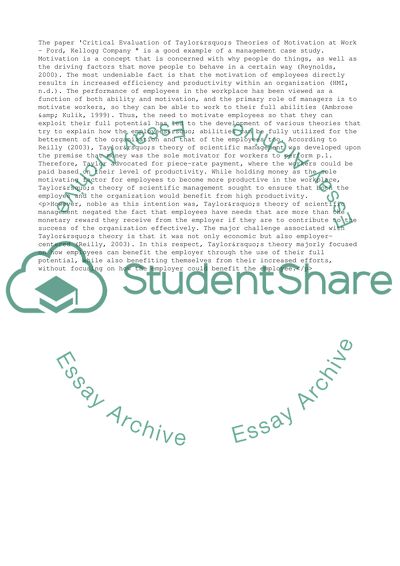Cite this document
(Critical Evaluation of Taylors Theories of Motivation at Work - Ford, Kellogg Company Case Study Example | Topics and Well Written Essays - 2500 words, n.d.)
Critical Evaluation of Taylors Theories of Motivation at Work - Ford, Kellogg Company Case Study Example | Topics and Well Written Essays - 2500 words. https://studentshare.org/management/1850221-critical-evaluation-of-taylors-theories-of-motivation-at-work-ford-kellogg-company
Critical Evaluation of Taylors Theories of Motivation at Work - Ford, Kellogg Company Case Study Example | Topics and Well Written Essays - 2500 words. https://studentshare.org/management/1850221-critical-evaluation-of-taylors-theories-of-motivation-at-work-ford-kellogg-company
(Critical Evaluation of Taylors Theories of Motivation at Work - Ford, Kellogg Company Case Study Example | Topics and Well Written Essays - 2500 Words)
Critical Evaluation of Taylors Theories of Motivation at Work - Ford, Kellogg Company Case Study Example | Topics and Well Written Essays - 2500 Words. https://studentshare.org/management/1850221-critical-evaluation-of-taylors-theories-of-motivation-at-work-ford-kellogg-company.
Critical Evaluation of Taylors Theories of Motivation at Work - Ford, Kellogg Company Case Study Example | Topics and Well Written Essays - 2500 Words. https://studentshare.org/management/1850221-critical-evaluation-of-taylors-theories-of-motivation-at-work-ford-kellogg-company.
“Critical Evaluation of Taylors Theories of Motivation at Work - Ford, Kellogg Company Case Study Example | Topics and Well Written Essays - 2500 Words”. https://studentshare.org/management/1850221-critical-evaluation-of-taylors-theories-of-motivation-at-work-ford-kellogg-company.


